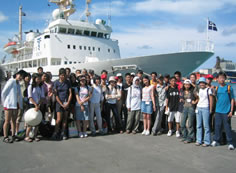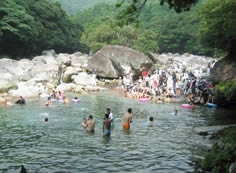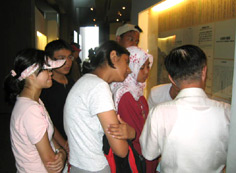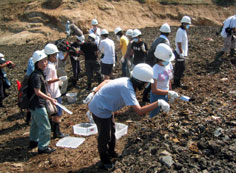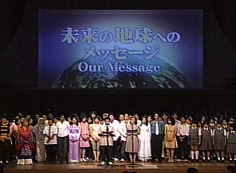|
MONTHLY NEWS Voyage to the Future | ||||||||||||||||||||
This summer, 42 young people from seven Asian countries took part in a special program to learn about the environment. The participants came from India, Japan, Malaysia, Singapore, South Korea, Thailand, and Vietnam, all countries facing different sorts of environmental problems. The 16-day program began on August 1, and the highlight was a 10-day voyage in which the participants traveled by ship from Okinawa to Yokohama, stopping at a number of places in Japan along the way. On this trip they learned about global environmental problems from famous people who gave them lessons on the ship and at the different stops, as well as by taking part in lots of hands-on activities. The journey, which was called Voyage to the Future, took its name from the hope that through the program, these young people would think about how environmental problems should be addressed in the years to come. The event was sponsored by NHK (Japan Broadcasting Corp.), the Nihon Keizai Shimbun (a Japanese newspaper), and Tokai University. Kids all around Japan were able to experience the 10-day voyage in real time during the summer vacation through daily reports on TV, in newspapers, and on the Internet.
Before the ship set sail, the 42 participants learned about the amazing amount of marine life in the beautiful waters of Okinawa. After boarding the oceanic survey vessel Bosei Maru, the participants went to Yakushima, an island south of Kyushu. A large portion of Yakushima was designated a World Heritage site in 1993, and the weather on the island is so wet that people joke it rains "35 days a month" there. The large amount of rainfall has given Yakushima a rich forest and marine environment. When rainwater runs off the island, it carries nutrients into the sea, and these nutrients help to sustain marine life. The students experienced for themselves the wonders of the natural water cycle on Yakushima and, as they played in the river and went hiking in the spectacular forest, they learned about the importance of water and trees in sustaining Yakushima's unique environment.
The next stop on the Voyage to the Future was Minamata, a town in southwest Kyushu. Minamata became famous when Minamata disease broke out there in 1956. Metal methylmercury discharged into the sea from a local factory had polluted fish and shellfish in the bay. People who ate the fish over a long period got Minamata disease. The voyage participants all visited the Minamata Disease Municipal Museum to learn about the tragedy, and they had the chance to speak with people who are still suffering from the disease. Afterward, the students held a lively discussion about what they learned and what they should tell future generations. They decided that economic development should take place in harmony with nature, and everyone thought long and hard about the true meaning of prosperity.
On the seventh day of the voyage, the group visited the island of Teshima in the Seto Inland Sea, where they went to see an illegal dump of industrial waste. They learned how difficult it is to restore polluted water and soil to its former state. At Suruga Bay, which is the deepest point in the sea surrounding Japan, the participants learned about the mysterious creatures that live in the depths of the sea. Dan Hiroki, the Japanese participant, said he was especially interested in exploring the lives of very small living creatures. Hiroki and the others also studied marine pollution and learned about the global environment using a satellite in space.
After reaching the goal in Yokohama, the 42 participants took part in the Grand Finale, where they made presentations on their journey at a concert hall in Yokohama. The event, which featured performances by a youth orchestra and youth choir and appearances by special celebrity guests, was attended by nearly 2,000 people and watched by many more on TV at home. The 42 young people recounted their experiences with the audience and shared what they had learned, and at the end two representatives of the group read the proposal for the future that they and their friends had spent many hours writing. Many of the participants cried at the end because they didn't want to say goodbye. It is hoped that in the future the participants will tell others what they experienced and learned on the voyage and that they will put those lessons into practice by tackling environmental issues themselves. As they returned to their home countries after the voyage, the participants took with them many hopes and dreams for the future. NOTICE: Since October 9, 2003, Japanese names in Kids Web Japan have been written in their original order: surname first. |
 |
